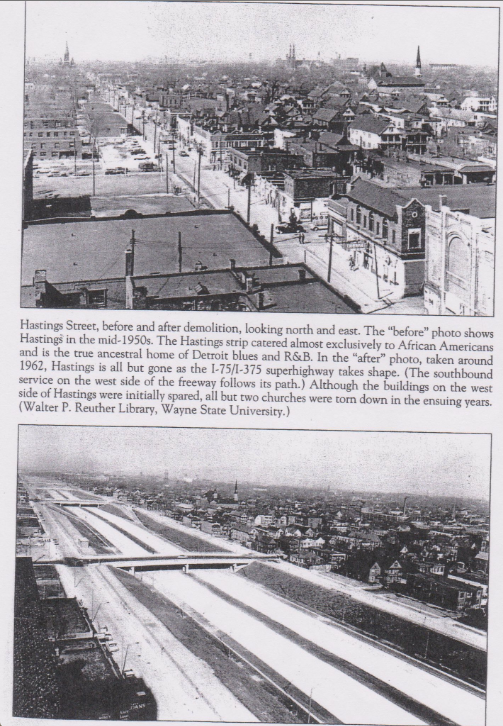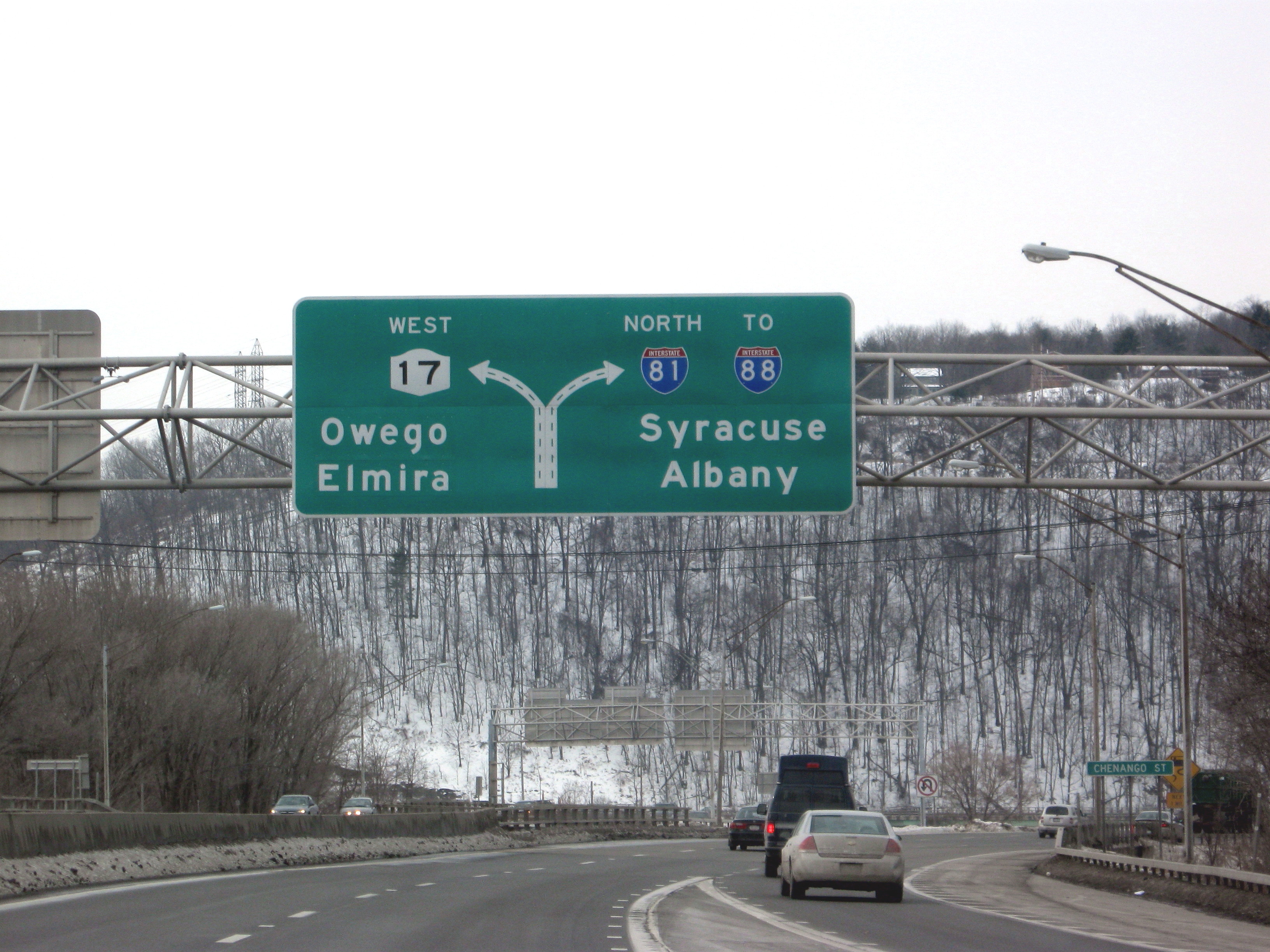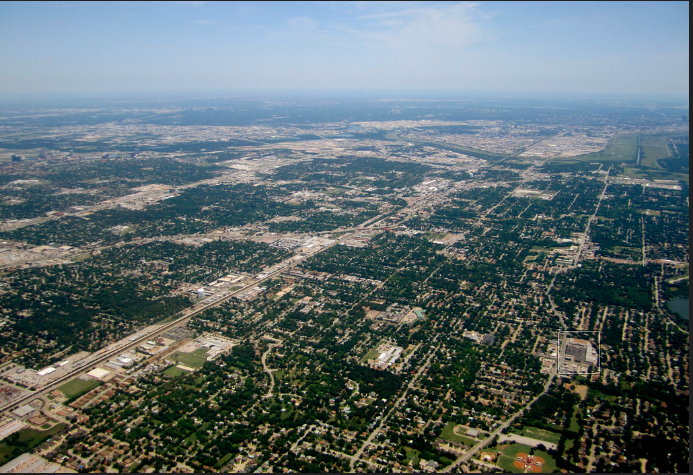These Highways Are So Bad They're Even Keeping People Poor

By:
Rush-hour traffic isn't the only unpleasant byproduct of the United States' sprawling highway system: Transportation infrastructure can also exacerbate economic and racial inequality.
In a new report, "Freeways Without Futures," the Congress for the New Urbanism (CNU) list 10 of the country's worst highways. Some of the highways singled out by the CNU produce outsized traffic problems and noise pollution, while others have detrimental impacts on low-income and minority communities.
Here are five highways that actually make economic and racial inequality worse, according to the report.
1. Interstate 375 (Detroit, Michigan)
The I-375 expressway was erected in the 1940s as part of an “urban renewal” program that resulted in the eviction and demolition of predominately black neighborhoods, urban historian Raymond A. Mohl explained in a 2002 paper.
“Black Bottom, Paradise Valley, was indeed a paradise for Black entrepreneurial businesses,” Sidney Barthwell Jr., 66, who served as a 36th District Court magistrate, told the Detroit Free Press in a 2013 piece republished on the blog Keep Ypsi Black. Barthwell's father ran ice cream shops and a pharmacy chain in the area.
 Twitter/mactavish - twitter.com
Twitter/mactavish - twitter.com
“Funeral homes, doctors — there were a dozen different Black-owned hospitals (in Black Bottom), because in those days, they wouldn’t admit you into the major hospitals if you were African-American,” he continued. “The Detroit Black community in its heyday was absolutely fantastic. It was better than Harlem.”
In a 2013 piece for the Metro Times, reporter Ryan Felton linked Detroit's freeways to the city's declining population and economic fortunes.
"Thanks in large part to a system that allowed those with cars to commute to jobs in the city, Detroit’s population began to fall, slowly at first, then accelerating as the exodus helped create a downward economic spiral," Felton wrote. "The more people left, the more the city’s tax revenues declined, leading to reductions in service and quality of life, and exacerbating growing social problems. Those deteriorating conditions prompted even more people to flee, forcing tax revenues even lower. On it went, helping bring the Motor City to where it is today, on the verge of bankruptcy."
Advocates of tearing down the freeway argue the area could be used to create public parks, pedestrian walkways, and commercial developments that would stimulate economic growth.
2. Interstate 81 (Syracuse, New York)
New York's Viaduct freeway also displaced predominately Black communities and shuttered businesses. This effectively created two cities segregated by race and class, NPR reported in 2012.
Syracuse had the highest concentration of Black and Hispanic poverty in the country in 2015 and the problem is most severe near the highway, the Atlantic reports. From the Atlantic:
"The poverty is more evident a few blocks away, where families are crowded into public housing near the overpass of I-81, an elevated highway that cuts through the heart of the city. There are no supermarkets here, just small convenience stores that advertise that they sell cigarettes and accept food stamps. Across the street from one store, men and women sit in an empty lot, some in rolling office chairs, others leaning on cars or rickety shopping carts."
Syracuse resident Hazel Miller told NPR the highway repelled commerce. "We don't even have a grocery store close," she said.
"It's not a question of if it should be torn down," said Syracuse Common Council President and local NAACP chapter founder Van Robinson. "The question is when will it be torn down."
 Wikipedia Commons - wikipedia.org
Wikipedia Commons - wikipedia.org
3. I-345 (Dallas, Texas)
An extension of the city's Central Expressway, I-345 isolates residents of South Dallas from the central business district and other parts of the city.
 Flickr/La Citta Vita - flickr.com
Flickr/La Citta Vita - flickr.com
The construction of the elevated highway destroyed predominately Black neighborhoods and resulted in vast racial, socioeconomic and cultural disconnects, North Texas Conference of the United Methodist Church connection director George Battle III explained in a Dallas News opinion piece.
"I-345 matters to South Dallas, and specifically to black Dallas, because it brings justice to neighborhoods and a community of people historically neglected, displaced and long cheated of opportunity, by bringing economic development southward," he wrote. "If only the flow of vitality would not be blocked or paved over by and for the few."
Over a third of South Dallas's 30,000 residents live in poverty, the Dallas News reported May. South Dallas and Fair Park neighborhoods are cut off from the rest of the city as a result of the I-345 and I-30 highways, which exacerbate poverty and isolate residents, the report claims.
4. I-70 (Denver, Colorado)
Denver's I-70 viaduct is the site of ongoing controversy. It has historically cut off low-income Latino communities from accessing basic resources and subjected them to large amounts of pollution. Yet the Colorado Department of Transportation plans to tear it down only to replace it with a larger highway. The Sierra Club filed a lawsuit against the EPA in response to the proposal in December. The suit is still pending.
The highway-adjacent Elyria-Swansea neighborhood is over 80 percent Latino, with a third of residents living in poverty, according to the Sierra Club.
“This highway has been an injustice ever since it was put in more than 50 years ago,” said Candi CdeBaca, leader of neighborhood group Cross Community Coalition. She thinks the highway is deterring businesses and depressing property values, according to a piece from the Sierra Club.
The highway also seems to be making people ill: Children who live near the interstate have a 40 percent higher urgent care visits for severe asthma rates than their peers, according to a 2014 report from Denver’s Environmental Health Department.
5. I-980 (Oakland, California)
Oakland's I-980 highway spur is yet another example of an infrastructure project that imperiled low-income minority neighborhoods. Built to improve commutes, the freeway remains underutilized despite taking up massive space and cuts West Oakland off from other parts of the city, the CNU report explains.
The movement to remove it goes back to the 1980s. The citizen-led campaign ConnectOAKLAND, launched in 2014, advocates for removing the I-980 to create 21 city blocks.
"We believe the I-980 project must focus on equity, integration and investment in the community,” campaign founder Chris Sensenig told the CNU.
The project has garnered support from local politicians including Oakland Mayor Libby Schaaf. The Oakland City Council will consider a planning proposal that includes the freeway's removal on Feb. 7, the East Bay Times reports.
You can read the full report on the CNU.
